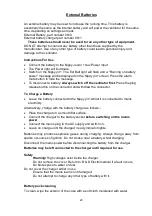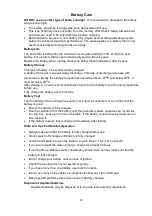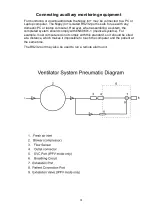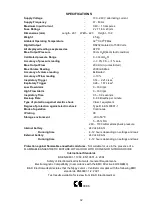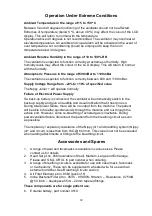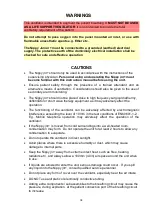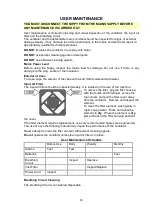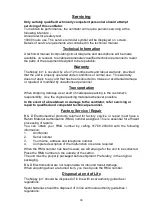
23
SETTING UP THE NIPPY
in IPPV MODE
Before starting to set up the ventilator, assess the patients breathing pattern. You will need
to know the breath rate and the approximate inspiratory time (Ti).
1.
Place the Nippy on a clean, level surface.
2.
Connect the breathing circuit tube to the outlet. It is
recommended that a Bacterial filter be fitted between the
outlet and the 22mm diameter breathing tube.
3.
Connect the small exhalation valve tube to the EVC outlet.
4.
Connect the mask to the outlet tubing on the breathing
circuit.
Note: Do not fit the mask onto the patient at this point.
5.
Press the Start/Stop button and select IPPV mode.
6.
Set the High Alarm to 160 lpm and the Low Alarm to 20 lpm. This will help to stop the
alarm becoming a nuisance during setting up. Alarm settings will be finalised later
7.
Start with a low pressure to avoid distressing the patient. Set IPAP to around 8cm H2O
(or less for weak, frail patients).
Avoid starting off with the pressure too high.
8.
Set Ti to match the patient. (In patients without airflow obstruction, it would be
reasonable to start with an inspiratory time of 1.0 - 1.5 seconds).
9.
The patient may now
hold
the mask to the face.
10. Allow the patient to get used to the mask. Then
gradually
increase the IPAP setting
until the patient feels comfortable and is being ventilated efficiently. 10 to 20cm H2O
will suit most patients.
11. Fine-tune the Inspiratory time (Ti) to the comfort of the patient.
12. If the Inspiratory trigger needs to be adjusted, select “Adjust trigger level” from the
menu and adjust to suit the patient.
13. Read the rate from the display (top of screen). This should match the value observed
when assessing the patient. If the rate has increased, make sure that the trigger is not
so sensitive that it is causing “self triggering”. It may be due to the patient’s anxiety at
trying a new treatment. Stay with the patient while he / she settles down. When the rate
has settled, set the Back-up to a value a few BPM below the patient’s rate. Allowance
should be made for a reduction in rate when the patient falls asleep. Then strap the
mask/headset to the patient.
14.
Set Up the alarms, as detailed in the “Setting Up the Alarms” section of this manual
Test the alarms as detailed in “Alarm Conditions and Tests” section of this manual.
15. Check the rate and alarms when the patient is asleep. The inspiratory trigger indicator
should “flash” at the beginning of each breath.
16. Lock the settings to prevent unauthorised adjustment. See back page.
Disconnect the patient outlet port, before switching off.





















